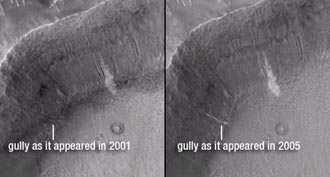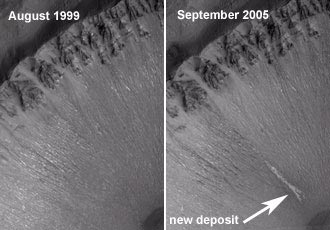Photos of water suggest possibility of life on Mars
Photos of water suggest possibility of life on Mars
mongabay.com
December 6, 2006
New NASA photos suggest the existence of water on Mars. The finding could suggest the possibility of life of the planet.
“These observations give the strongest evidence to date that water still flows occasionally on the surface of Mars,” said Michael Meyer, lead scientist for NASA’s Mars Exploration Program in Washington.
 A new gully deposit in a crater in the Centauri Montes Region. Image credit: NASA/JPL/Malin Space Science Systems  This set of images shows a comparison of the gully site as it appeared on Dec. 22, 2001 (left), with a mosaic of two images acquired after the change occurred (the two images are from Aug. 26, 2005, and Sept. 25, 2005). Sunlight illuminates each scene from the northwest (top left). The 150-meter scale bar represents 164 yards. Image credit: NASA/JPL/Malin Space Science Systems |
NASA says that liquid water is considered fundamental for life and that the images “heighten intrigue about the potential for microbial life on Mars.”
“The shapes of these deposits are what you would expect to see if the material were carried by flowing water,” said Michael Malin of Malin Space Science Systems. Malin is the lead author of the report, which published in the journal Science. “They have finger-like branches at the downhill end and easily diverted around small obstacles.”
NASA says that liquid water cannot persist long on Mars’ surface due to the thines of the atmosphere and extreme cold. However, the researchers propose that “water could remain liquid long enough, after breaking out from an underground source, to carry debris downslope before totally freezing.” The new images show two fresh deposits are each several hundred meters long.
“These fresh deposits suggest that at some places and times on present-day Mars, liquid water is emerging from beneath the ground and briefly flowing down the slopes. This possibility raises questions about how the water would stay melted below ground, how widespread it might be, and whether there’s a below-ground wet habitat conducive to life. Future missions may provide the answers,” said Malin.
This article is based on a news release from NASA.